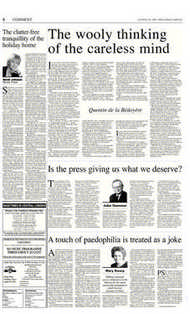Page 14, 20th August 2004
Page 14

Report an error
Noticed an error on this page?If you've noticed an error in this article please click here to report it.
Tags
Share
Related articles
'understanding That We Cannot Understand
The Last Word
Gethsemane Is The Place We Are Put To The Test
Grasping The4ipof An Iceberg: How We Miss The Immensity...
LASTWORD
Conceiving of God in metaphor and reality Ronald Rolheiser
Our generation struggles with believing in God, not that this, as Reginald Bibby states, puts God in trouble. God isn’t in trouble because people stop believing or going to church.
Today, God is not so much denied as ignored; though there are growing numbers of people who now profess that they no longer believe in God. Those numbers, however, aren’t nearly as high as is commonly supposed. Atheism is still relatively rare and, as Michael Buckley says, is not a problem, but “a situation, an atmosphere, a confused history”. Of more concern, I believe, are the ways we try to think of God. On the one hand, we see a creeping fundamentalism, where our concepts and language about God are being taken ever more literally. The bible is taken as a history book and the language surrounding God is taken at face value.
On the other hand, we see a tendency to take the symbolic character of religious language to its extreme, namely, to a place where it excludes all claims to ontology (as having any reference to anything that actually exists in the real world). God then becomes just a symbol, a myth, not real in the normal sense.
Both of these views are gaining in popularity. Fundamentalism is appealing, more and more, to those who are tired of a relativism wherein everything can mean anything, and the reduction of God to a symbol is attracting more and more people who, rightly, have grasped that the human mind and imagination cannot wrap themselves around the idea of God in a literal way. So what’s to be said about this?
Karl Rahner said: “We are just discovering today that one cannot picture God to oneself in an image that has been carved out of the wood of the world ... This experience is not the genesis of atheism, but the discovery that the world is not God.” What is contained in this? First, that God is ineffable. God cannot be captured in any picture inside the imagination, or concept within the mind, and all our language about God is, by definition, necessarily metaphor, analogy, and is more inaccurate than accurate. God cannot be thought of or spoken about in the way we think about and speak about anything else.
Consequently, we must be wary of taking religious language too literally. When we turn metaphor into physics, we set ourselves up for the impossible task of trying to conceptualise the infinite within finite categories. That leads to atheism, because when we try to literally picture God and imagine God’s existence, the imagination runs dry and we conclude that, because God is unthinkable, God doesn’t exist. But that isn’t a necessary equation; knowing and thinking are not the same thing. We know infinitely more than we can ever think.
However, for Christianity, Judaism, and Islam, God is more than an impersonal force, the deepest principle of life, the intelligent DNA inside of evolution, directing things. God is that, but more. While God is not a person, who can be thought of in the same way we think of ourselves and other people, God is a person in the sense that at some deep place there is a divine mind, heart, and personality that is meant to be personally related to, and is meant to be the object of, worship, love, affection, and appeal. God is both symbol and reality.
In his autobiographical writings, Nikos Kazantsakis makes an interesting confession. Late on in life, he came to believe that Christianity happened because Mary Magdalene loved Jesus so deeply that, after his death, she refused to let him die inside her heart and began to proclaim that he was alive.
Her story grabbed hold in the hearts of others and the rest is history. Christianity arose out of that love – and that lie. When Kazantsakis wrote Zorba, the Greek, he was trying, like Mary Magdalene, to give some immortality to Zorba because he loved him so deeply and thought him so exceptional. What happened?
Zorba, the Greek made for a good book and a great movie, but we don't measure time by Zorba’s birth. Kazantsakis’ wish to bestow a divinity and immortality on Zorba didn’t exactly take off and shape history in the way the resurrection of Jesus did. Why not?
Because, for a religious myth to have a long-term grip on history and on the hearts of hundreds of millions of people, more than just a symbol needs to be involved.
The great religions of the world have their staying power because, at least at a few key times, a God who is very real, alive, and personal, manifested a real, physical, tangible presence within actual history.
blog comments powered by Disqus















